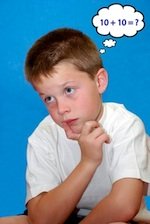Being great at mental math doesn’t happen by magic, but it sure looks like it. Give your students strategies they can quickly master and they can become math magicians too.
Mental exercises in math is the last part of a Daily Math Review. It is an important part of a daily lesson as students need to practice strategies without pencil and paper.
It also brings in oral talk and discussion about math concepts so kids are able to share and question how their peers choose to solve problems.
Teaching shortcuts and strategies helps prioritize talking about mathematical thinking with our students. When we make this a priority as teachers our students will begin to value it.
Why Should We do Mental Maths?
There are three key reasons mental math is a critical part of elementary mathematics:
- It gives students practice with basic number facts and combining operations, which leads to mastering math facts.
- It reinforces number sense through number system properties, measurement concepts and math vocabulary.
- Patterns that exist within the number system are explored and will deepen conceptual understanding, such as doubling math facts.
Pattern recognition skills is something we use all the time, even if you don’t realize it. Our brains register patterns – the right side looks for patterns, rhythms and the “big picture.”
Mental math problems should follow a theme that allows students to begin to discover and analyze patterns.
However, it is a skill that many students need to develop and exercise to improve it.
In addition, doing mental math, as long as it is focused on patterns, could also enhance reading skills!
How? Because reading is pattern recognition. Small letter patterns, to CVC combinations, to larger patterns within a text…strategic skills are necessary to decode words as well as make meaning from a text.
When students use math shortcuts and strategies, they are making meaning with patterns along with mastering math facts.
Teaching Mental Math Strategies
Immediately after reviewing the Daily Math Practice & Review Questions, I dictate a series of numbers and operations. This is our daily oral math.
I go slow enough for all students to be able to process each step. The students write their answers in their math journals, I repeat the question, and then we check the answer.
That’s it. It’s so easy to implement and it reaps huge benefits for your students. However…there is a lot of thought and preparation that should go into this instruction.
Students also need to learn tips and tricks to be able to manipulate numbers in their heads. Do not assume your students will be able to use shortcuts without your direct instruction.
One way to directly teach this it to show students how to think about numbers as blocks.
It is also beneficial to train students to focus on finding number families. For example, write a number on the board that shows a number family, such as 6. You say “2” and the students respond with “4”, the number necessary to complete the sequence.
You can also use this technique in going up to 10 (our base number system). You say “2” and the students respond with “8”.
What you are doing is providing the foundation for learning the patterns that makes mathematics in base ten a manageable system to mentally work with.
Look at these math strategies that show how looking for patterns and at the bigger picture can help students add large numbers without needing to use pencil and paper.
Becoming skillful in mentally computing math problems is essential to mastering math facts. Try implementing it in your math lessons today!
